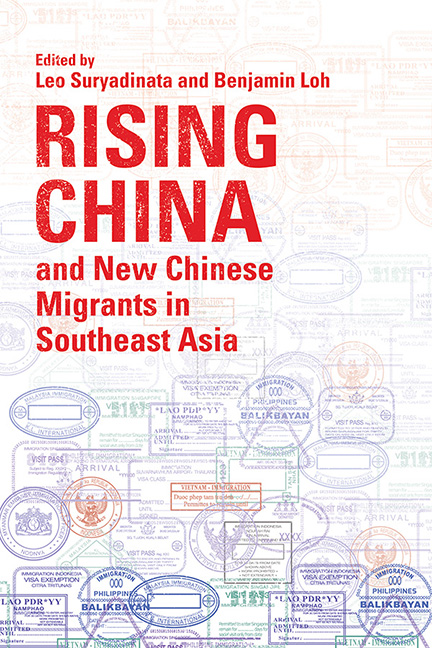Book contents
- Frontmatter
- Contents
- About the Contributors
- Introduction: Rising China and New Chinese Migrants in Southeast Asia
- Part I General Overviews on Rising China and Xin Yimin
- Part II China’s Soft Power, Xin Yimin and Local Communities
- Part III New Chinese Migrants and Local Communities
- Part IV New Chinese Migrants and Local Economies
- Index
1 - Rising China, New Migrants and Ethnic Chinese Identity in Southeast Asia
Published online by Cambridge University Press: 09 January 2024
- Frontmatter
- Contents
- About the Contributors
- Introduction: Rising China and New Chinese Migrants in Southeast Asia
- Part I General Overviews on Rising China and Xin Yimin
- Part II China’s Soft Power, Xin Yimin and Local Communities
- Part III New Chinese Migrants and Local Communities
- Part IV New Chinese Migrants and Local Economies
- Index
Summary
Since Deng Xiaoping introduced his four modernization programmes in 1978, China has risen, and its impact on Southeast Asia has also been strongly felt. This chapter briefly examines the impact of the programmes on the nation-building process in Southeast Asia. It will begin with a general observation of the ethnic Chinese position in Southeast Asian multi-ethnic nations, followed by a discussion about xin yimin or new Chinese migrants in the region and beyond, and finally an explication of Beijing’s new approach towards Chinese living in five Southeast Asian countries and its impact. These countries were chosen based on the availability of information on xin yimin to the author.
Southeast Asian countries with majority indigenous populations regard their ethnic Chinese as ‘migrants’ or ‘descendants of migrants’. Therefore, they are expected to be integrated, even assimilated, into the indigenous population. However, some are more integrated into their host society than others. In other words, all have adopted different degrees of local elements—which have made them different from mainland Chinese. The factors that have contributed to the intensive localization of ethnic Chinese in Southeast Asia are complex. Apart from Southeast Asian government policies, Beijing’s initial policy of encouraging localization was undoubtedly relevant.
Shift in Beijing’s Policy on Chinese Overseas
The policy of the People’s Republic of China initially followed the Kuomintang (KMT) position, treating all overseas Chinese as Chinese nationals. But at the 1955 Afro-Asian Conference in Bandung (also known as the Bandung Conference), Chinese Premier Zhou Enlai introduced a new policy later known as luodi shenggen (settle down and take local roots) to ease cooperation with the newly independent states in Southeast Asia and beyond. He encouraged overseas Chinese to take up local citizenship and integrate into local society. The majority of these ethnic Chinese have since become localized. In 1980, Deng Xiaoping issued the first nationality law based on single citizenship, which further encouraged Chinese overseas to localize and adopt local citizenship.
The rise of the Chinese following the success of Deng Xiaoping’s reform programme saw a new wave of migrants leaving China. Consequently, Beijing began adjusting its overseas Chinese policy.
- Type
- Chapter
- Information
- Rising China and New Chinese Migrants in Southeast Asia , pp. 19 - 30Publisher: ISEAS–Yusof Ishak InstitutePrint publication year: 2022

